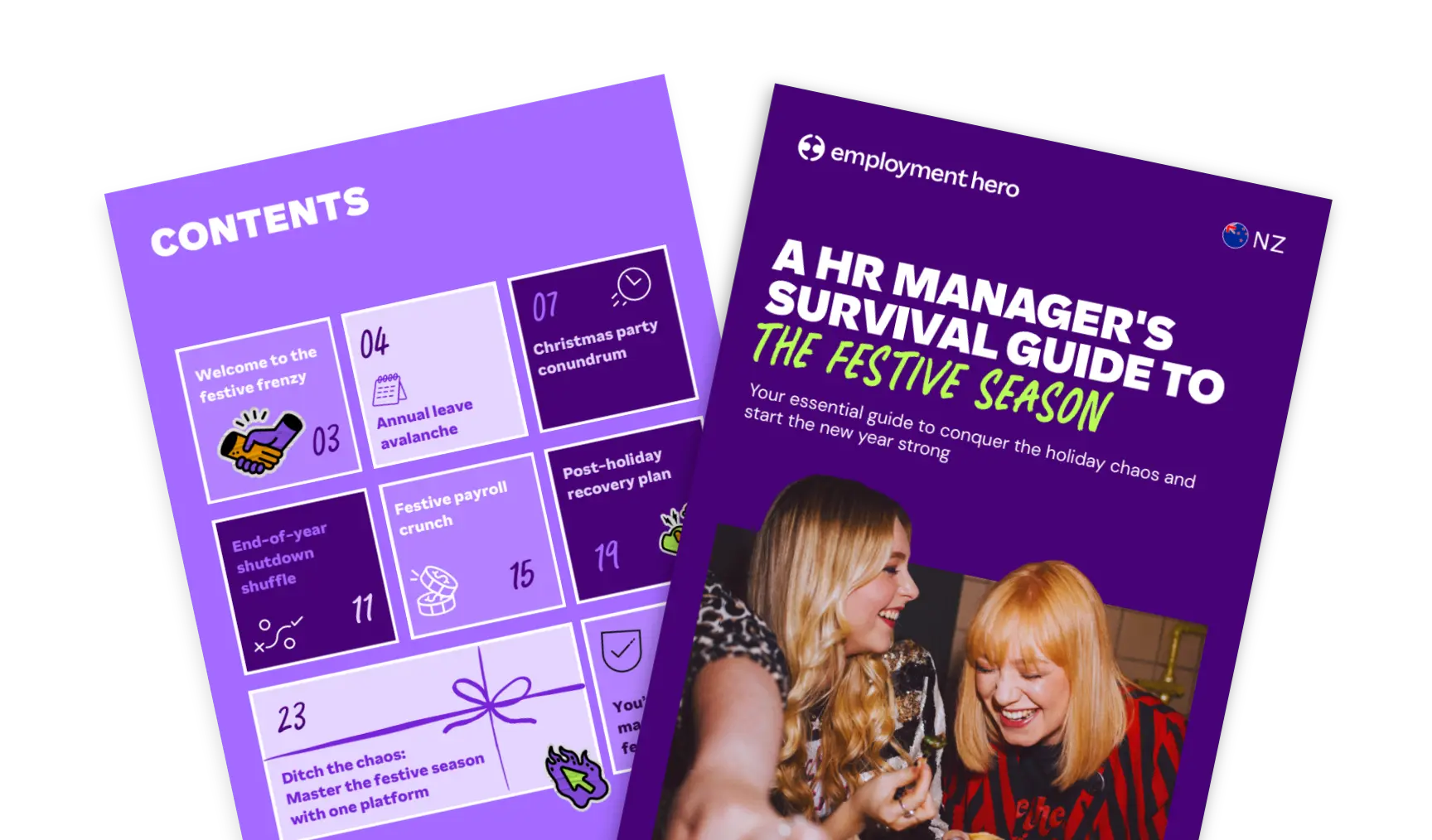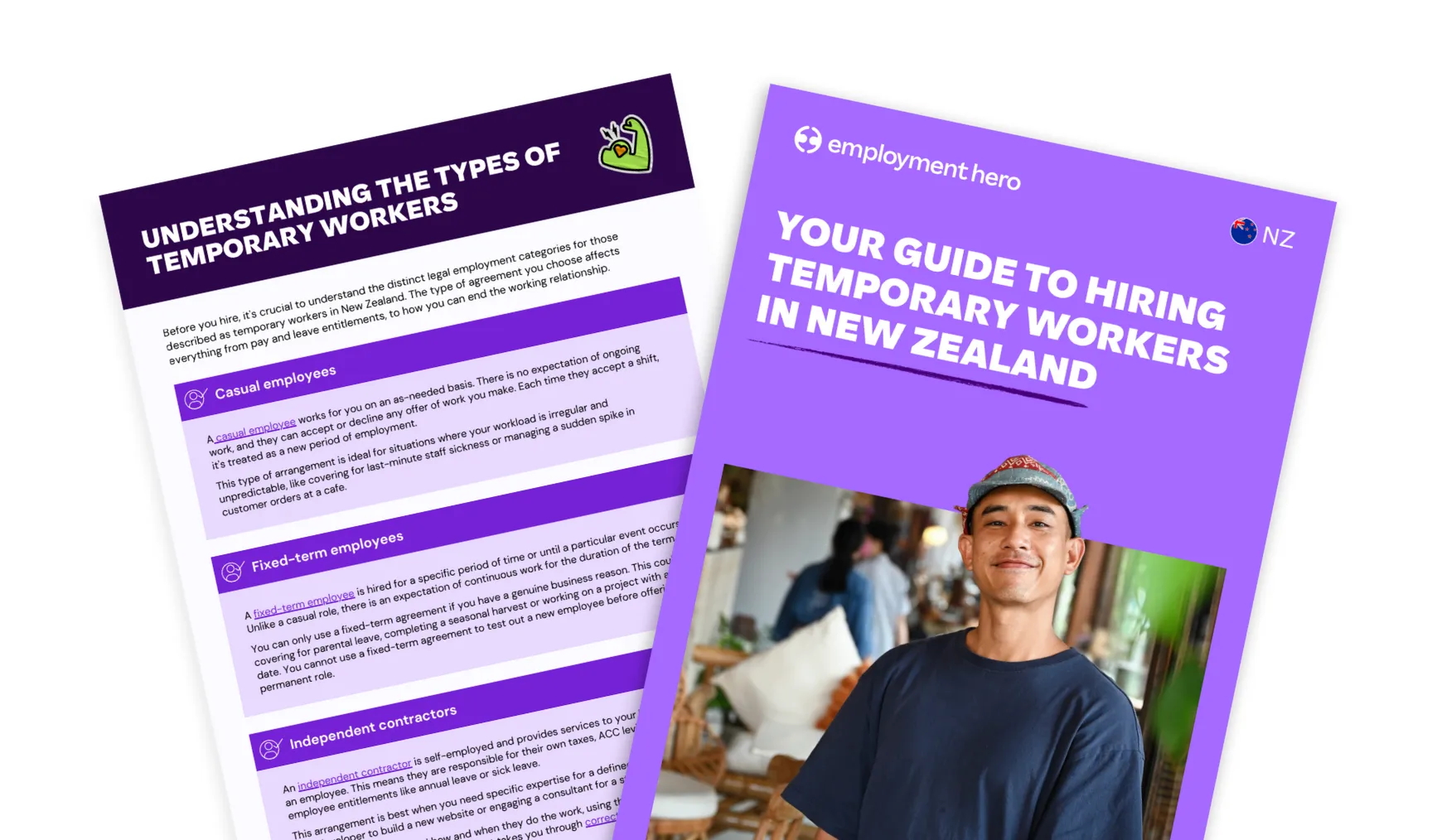Managing sick leave as an employer in New Zealand
Published
Managing sick leave as an employer in New Zealand
1 min read
For employers, managing sick leave can be a challenge. There’s a lot of different responsibilities and legal entitlements to be across.
That’s why we’ve created this guide, to take you through everything you need to know about sick leave at work.
The guide includes:
- Employee sick leave entitlements
- The sick leave request process
- Advice for supporting employees on sick leave
- Managing long-term sick leave
Fill out the form on the right to download the guide today.
Disclaimer: The information in this guide is current as at 10 August 2023, and has been prepared by Employment Hero Pty Ltd (ABN 11 160 047 709) and its related bodies corporate (Employment Hero). The views expressed in this guide are general information only, are provided in good faith to assist employers and their employees, and should not be relied on as professional advice. The information is based on data supplied by third parties. While such data is believed to be accurate, it has not been independently verified and no warranties are given that it is complete, accurate, up to date or fit for the purpose for which it is required. Employment Hero does not accept responsibility for any inaccuracy in such data and is not liable for any loss or damages arising either directly or indirectly as a result of reliance on, use of or inability to use any information provided in this guide. You should undertake your own research and seek professional advice before making any decisions or relying on the information in this guide.
What is sick leave?
Sick leave is a period of time during which your employees are not present at work, whether due to temporary or extended health issues. It can be used when the staff member is experiencing poor health, or when their partner or dependent requires care due to illness or injury.
Can employers deny a sick leave request?
There is no law to stop employers denying a sick leave request. However, if the employee has sick leave to use, they have a right for that request to be considered fairly and in good faith by the employer.
Can employers ask for a medical certificate?
Yes, employers can ask for proof of illness in the event of a sick leave request. This can come in the form of a note from the doctor or a formal medical certificate.
 Minimum sick leave entitlements for NZ employees
Minimum sick leave entitlements for NZ employees
In New Zealand, there are minimum paid sick leave entitlements for all employees, regardless whether they’re full-time, part-time or casual.
Employers can also add additional sick leave privileges at their discretion – for example, unlimited sick leave or flexible hours of work to make time for attending medical appointments. This should be specified in an employment agreement.
Paid sick leave
All employees have 10 days of sick leave entitlement per year, provided they match the following criteria:
- They have worked for six months for the same employer, or
- They have worked for the employer for six months for:
- An average of 10 hours per week, and
- At least one hour in every week, or 40 hours in every month.
Sick leave is paid at the rate of relevant daily pay. The only exception is if it’s not possible to calculate the employee’s daily pay, or if it varies in the pay period where the leave falls. In those instances, the employer can use average daily pay.
Unused sick leave
At the end of the year period, up to 10 days of unused sick leave can be carried over and added to the following year’s entitlement.
Tips for effective sick leave management
Have clear workplace policies in place
In a fair workplace, every employee requesting sick leave should have the same experience. That’s where workplace policies come in useful, as they can provide singular guidelines that everyone can follow across the business.
Make sure you’ve got a policy that summarises exactly what is expected from employees in requesting and using sick leave, and what is expected from employers in granting it.
 Review your health and safety practices
Review your health and safety practices
Ideally, no one would have ill health caused by their job. However, workplace incidents happen and can lead to lengthy sick leave.
Employers should ensure they’ve got a strong workplace health and safety policy and that they regularly assess their workplace and business for potential risks.
Examine your workplace culture
In busy or high pressure work environments, employees may sometimes overlook the importance of taking time off. This can create something of a vicious cycle – if employees try to ‘push through’ and work while sick or injured, it can affect team morale and, if infectious, the employee can pass on their illness to their colleagues.
It’s important that leaders set a good example and encourage their teams to take leave when they need it. They should also ensure that there’s sufficient cover in the event of an absence, so that employees feel reassured that their work can continue without them.
Managing sick leave absences
What happens if an employee runs out of sick leave?
If the employee has no sick leave balance left, the employer and employee can agree on one of the following options:
- The employee uses next year’s sick leave entitlements in advance.
- The employee uses some of their annual leave.
- The employee takes unpaid leave.
How can employers address frequent and unscheduled absences?
If an employee consistently takes unexpected sick leave days, it may indicate underlying issues beyond the surface. Dissatisfaction with their role could stem from factors like rigid micromanagement and a lack of support or recognition for employee wellbeing. Burnout could also be a contributing factor.
Considering this, conducting a confidential check-in with the employee could prove beneficial. Employers should convey their genuine concern for the employee’s wellbeing and willingness to address any concerns about the workplace. If issues are raised, it presents an opportunity to explore potential solutions.
Should the pattern of sick leave persist, employers have the right to request proof of illness for each sick leave request, as outlined above. They may withhold sick leave pay if no evidence is provided. Employers should carefully and consider all options before withholding sick pay.
 Support your team today for a healthy and happy workplace
Support your team today for a healthy and happy workplace
Sick leave management is an important part of leading a team of people. Get it right, and you’ll benefit from a supportive culture of employees who feel empowered to bring their best selves to work.
Download our guide today for a comprehensive view of everything you need to know about managing sick leave.
Register for the guide
Related Resources
-
 Read more: HR Managers: Don’t just survive the festive season, master it
Read more: HR Managers: Don’t just survive the festive season, master itHR Managers: Don’t just survive the festive season, master it
Make year-end easier: manage leave, payroll, parties and shutdowns with confidence. Get practical tips for NZ SMEs. Download the free…
-
 Read more: Outsourcing payroll in New Zealand: Guide for employers
Read more: Outsourcing payroll in New Zealand: Guide for employersOutsourcing payroll in New Zealand: Guide for employers
Learn how payroll outsourcing works in NZ, its benefits and risks, and how Employment Hero NZ makes it simpler and…
-
 Read more: How to hire temporary workers in New Zealand: Employer’s guide
Read more: How to hire temporary workers in New Zealand: Employer’s guideHow to hire temporary workers in New Zealand: Employer’s guide
Learn how to hire temporary workers in NZ. Understand fixed-term agreements, pay, compliance, onboarding and where to find temporary staff.





















